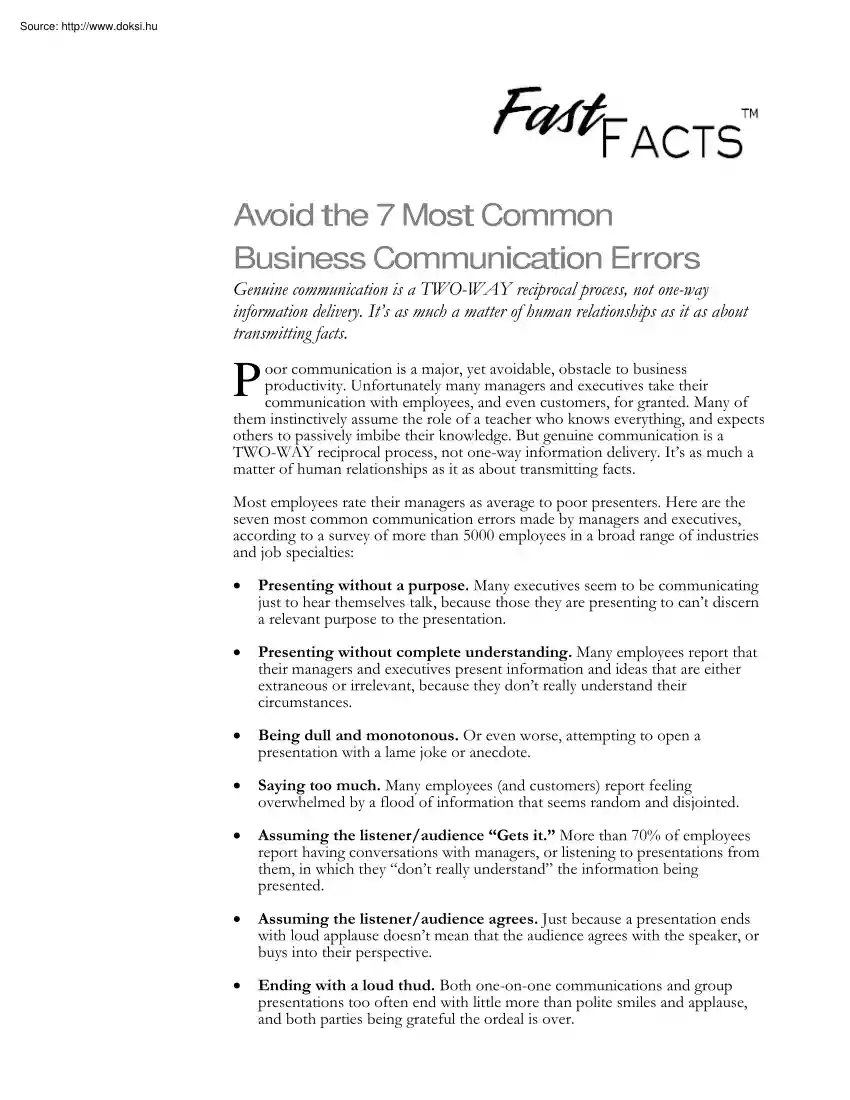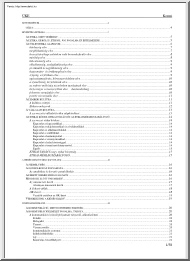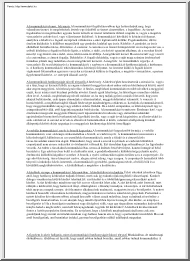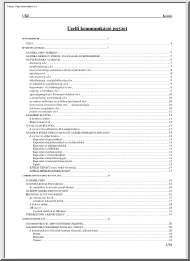Datasheet
Year, pagecount:2004, 3 page(s)
Language:English
Downloads:16
Uploaded:July 14, 2013
Size:105 KB
Institution:
-
Comments:
Attachment:-
Download in PDF:Please log in!
Comments
No comments yet. You can be the first!Most popular documents in this category
Content extract
Avoid the 7 Most Common Business Communication Errors Genuine communication is a TWO-WAY reciprocal process, not one-way information delivery. It’s as much a matter of human relationships as it as about transmitting facts. oor communication is a major, yet avoidable, obstacle to business productivity. Unfortunately many managers and executives take their communication with employees, and even customers, for granted. Many of them instinctively assume the role of a teacher who knows everything, and expects others to passively imbibe their knowledge. But genuine communication is a TWO-WAY reciprocal process, not one-way information delivery. It’s as much a matter of human relationships as it as about transmitting facts. P Most employees rate their managers as average to poor presenters. Here are the seven most common communication errors made by managers and executives, according to a survey of more than 5000 employees in a broad range of industries and job specialties: •
Presenting without a purpose. Many executives seem to be communicating just to hear themselves talk, because those they are presenting to can’t discern a relevant purpose to the presentation. • Presenting without complete understanding. Many employees report that their managers and executives present information and ideas that are either extraneous or irrelevant, because they don’t really understand their circumstances. • Being dull and monotonous. Or even worse, attempting to open a presentation with a lame joke or anecdote. • Saying too much. Many employees (and customers) report feeling overwhelmed by a flood of information that seems random and disjointed. • Assuming the listener/audience “Gets it.” More than 70% of employees report having conversations with managers, or listening to presentations from them, in which they “don’t really understand” the information being presented. • Assuming the listener/audience agrees. Just because a presentation
ends with loud applause doesn’t mean that the audience agrees with the speaker, or buys into their perspective. • Ending with a loud thud. Both one-on-one communications and group presentations too often end with little more than polite smiles and applause, and both parties being grateful the ordeal is over. So what can you do to avoid these errors? Here are seven effective strategies to help you communicate in a way that’s clear, concise and relevant to employees and customers: 1. Begin at the End Almost every effective business communication is in some way a “call to action” and you should pre-determine the specific outcome or action you want to achieve. Do you want an employee to change their work habits? Do you want a customer to buy your product? Do you want the shareholders to approve the merger? Decide in advance a specific objective that requires action or commitment on the part of your audience. If you can’t think of a specific outcome that requires action of
commitment, then maybe you should be asking yourself if the communication is really necessary at all. Because if the only purpose is delivery of data, there are probably more efficient ways of doing it. 2. Listen First, Speak Second Every presentation, every conversation, and virtually every other interpersonal communication should begin with questions that enhance the speakers understanding of the other person (or group). Admittedly, this rarely happens Most speakers and presenters are so focused on THEIR message that they forget the real priority is the other person. Of course questions take time, and listening to answers takes even more time, but if we want to consistently communicate in a way that’s relevant to others, we have to make sure that we truly understand their perspective. 3. Earn Attention Never assume you have someone’s full attention, because most people have a multitude of thought and ideas flowing through their mind at any one time. Their mental “noise"
consists of everything that distracts them including noise in the literal sense, physical or emotional discomfort, personal problems, negative attitudes, or distracting mannerisms. This is why gaining attention – EARNING attention – is an important prerequisite for effective communication. Some people do this with an amusing anecdote, or a compelling personal story, and this works well in many circumstances if you have the ability to do it naturally. But you can also gain attention by presenting new information (the results of a surprising new research study, etc.) that’s directly relevant to their situation 4. Present with Brevity Oscar Wilde was quoted as saying “Brevity is the soul of wit.” It’s also the soul of effective business presentations. Whether you are delivering a keynote address, presenting a proposal to a prospective customer, or introducing yourself to a new employee, the essence of clear communication is brevity. When you commit yourself to concise,
succinct communication it forces you to think through your most important points and to present them without a lot of “fluff” or extraneous information. We’re living in the age of 30-second commercials, and most people expect you to make a point pretty quickly, then move on to your next point, and your next, etc. Lengthy, drawn-out explanations or stories will do nothing but bore most people. So even if you have to deliver fairly intricate, complex information, break it up into information “packets” or “chunks” then make sure each element has “payoff” for the audience. 5. Confirm Understanding This means a lot more than just asking “Do you understand?” In fact, you can always assume that when you ask employees directly if they understand you, the answer will be “yes” whether or not they really do understand. And you can assume the same thing of customers, because sometimes they don’t know they don’t understand. You can ask questions that indirectly let
you know whether they “get it” without putting them on the spot. Then, if you realize that they in fact don’t fully understand what you’ve been trying to communicate, you now have an opportunity to explain again. But remember, repetition isn’t communication, and if they didn’t understand something the first time, don’t just repeat yourself – find a new way to present the information. 6. Confirm Acceptance Understanding and accepting your message are two very different things. An employee may fully understand the basis of your criticism, or a customer may accurately comprehend the logic of your proposal. But that doesn’t mean they ACCEPT what you have presented. And again, asking “Do you agree?” isn’t an effective method, although that is essentially the information you’re after. Genuine acceptance of a concept presented by management, or by another worker, goes a long way towards ensuring active participation, and harmonious cooperation, in the workplace.
Acceptance of the information contained in a proposal goes a long way toward closing a sale. And the key to confirming acceptance is again to ask subtle questions that reveal acceptance without putting the listener on the spot. 7. Advocate Action Wrap up you communication with a specific “call to action.” This is the moment where you propel your abstract ideas or theoretical knowledge into the world of reality. Good ideas that aren’t translated into some sort of action rarely last And in most cases the action should be two-sided (remember, communication is reciprocal) so you’ve got to do you’re part as well as ask others to do theirs. Your first exposure to these ideas may seem a little overwhelming at first, but you’ll find that if you focus on them one at a time, letting yourself improve your communication efforts gradually, you’ll eventually develop an exceptional ability to communicate in a clear, concise and relevant manner you can be proud of
Presenting without a purpose. Many executives seem to be communicating just to hear themselves talk, because those they are presenting to can’t discern a relevant purpose to the presentation. • Presenting without complete understanding. Many employees report that their managers and executives present information and ideas that are either extraneous or irrelevant, because they don’t really understand their circumstances. • Being dull and monotonous. Or even worse, attempting to open a presentation with a lame joke or anecdote. • Saying too much. Many employees (and customers) report feeling overwhelmed by a flood of information that seems random and disjointed. • Assuming the listener/audience “Gets it.” More than 70% of employees report having conversations with managers, or listening to presentations from them, in which they “don’t really understand” the information being presented. • Assuming the listener/audience agrees. Just because a presentation
ends with loud applause doesn’t mean that the audience agrees with the speaker, or buys into their perspective. • Ending with a loud thud. Both one-on-one communications and group presentations too often end with little more than polite smiles and applause, and both parties being grateful the ordeal is over. So what can you do to avoid these errors? Here are seven effective strategies to help you communicate in a way that’s clear, concise and relevant to employees and customers: 1. Begin at the End Almost every effective business communication is in some way a “call to action” and you should pre-determine the specific outcome or action you want to achieve. Do you want an employee to change their work habits? Do you want a customer to buy your product? Do you want the shareholders to approve the merger? Decide in advance a specific objective that requires action or commitment on the part of your audience. If you can’t think of a specific outcome that requires action of
commitment, then maybe you should be asking yourself if the communication is really necessary at all. Because if the only purpose is delivery of data, there are probably more efficient ways of doing it. 2. Listen First, Speak Second Every presentation, every conversation, and virtually every other interpersonal communication should begin with questions that enhance the speakers understanding of the other person (or group). Admittedly, this rarely happens Most speakers and presenters are so focused on THEIR message that they forget the real priority is the other person. Of course questions take time, and listening to answers takes even more time, but if we want to consistently communicate in a way that’s relevant to others, we have to make sure that we truly understand their perspective. 3. Earn Attention Never assume you have someone’s full attention, because most people have a multitude of thought and ideas flowing through their mind at any one time. Their mental “noise"
consists of everything that distracts them including noise in the literal sense, physical or emotional discomfort, personal problems, negative attitudes, or distracting mannerisms. This is why gaining attention – EARNING attention – is an important prerequisite for effective communication. Some people do this with an amusing anecdote, or a compelling personal story, and this works well in many circumstances if you have the ability to do it naturally. But you can also gain attention by presenting new information (the results of a surprising new research study, etc.) that’s directly relevant to their situation 4. Present with Brevity Oscar Wilde was quoted as saying “Brevity is the soul of wit.” It’s also the soul of effective business presentations. Whether you are delivering a keynote address, presenting a proposal to a prospective customer, or introducing yourself to a new employee, the essence of clear communication is brevity. When you commit yourself to concise,
succinct communication it forces you to think through your most important points and to present them without a lot of “fluff” or extraneous information. We’re living in the age of 30-second commercials, and most people expect you to make a point pretty quickly, then move on to your next point, and your next, etc. Lengthy, drawn-out explanations or stories will do nothing but bore most people. So even if you have to deliver fairly intricate, complex information, break it up into information “packets” or “chunks” then make sure each element has “payoff” for the audience. 5. Confirm Understanding This means a lot more than just asking “Do you understand?” In fact, you can always assume that when you ask employees directly if they understand you, the answer will be “yes” whether or not they really do understand. And you can assume the same thing of customers, because sometimes they don’t know they don’t understand. You can ask questions that indirectly let
you know whether they “get it” without putting them on the spot. Then, if you realize that they in fact don’t fully understand what you’ve been trying to communicate, you now have an opportunity to explain again. But remember, repetition isn’t communication, and if they didn’t understand something the first time, don’t just repeat yourself – find a new way to present the information. 6. Confirm Acceptance Understanding and accepting your message are two very different things. An employee may fully understand the basis of your criticism, or a customer may accurately comprehend the logic of your proposal. But that doesn’t mean they ACCEPT what you have presented. And again, asking “Do you agree?” isn’t an effective method, although that is essentially the information you’re after. Genuine acceptance of a concept presented by management, or by another worker, goes a long way towards ensuring active participation, and harmonious cooperation, in the workplace.
Acceptance of the information contained in a proposal goes a long way toward closing a sale. And the key to confirming acceptance is again to ask subtle questions that reveal acceptance without putting the listener on the spot. 7. Advocate Action Wrap up you communication with a specific “call to action.” This is the moment where you propel your abstract ideas or theoretical knowledge into the world of reality. Good ideas that aren’t translated into some sort of action rarely last And in most cases the action should be two-sided (remember, communication is reciprocal) so you’ve got to do you’re part as well as ask others to do theirs. Your first exposure to these ideas may seem a little overwhelming at first, but you’ll find that if you focus on them one at a time, letting yourself improve your communication efforts gradually, you’ll eventually develop an exceptional ability to communicate in a clear, concise and relevant manner you can be proud of





 When reading, most of us just let a story wash over us, getting lost in the world of the book rather than paying attention to the individual elements of the plot or writing. However, in English class, our teachers ask us to look at the mechanics of the writing.
When reading, most of us just let a story wash over us, getting lost in the world of the book rather than paying attention to the individual elements of the plot or writing. However, in English class, our teachers ask us to look at the mechanics of the writing.